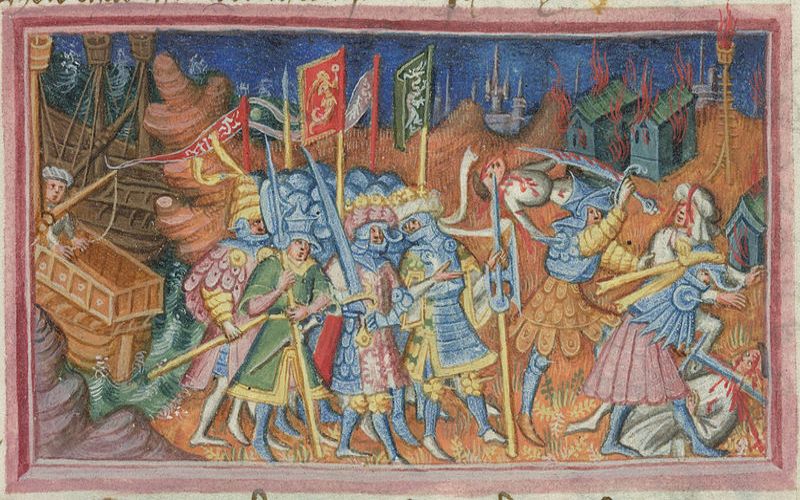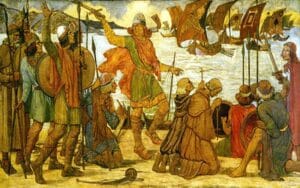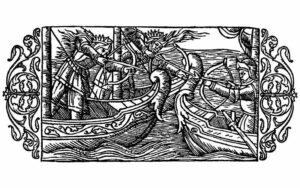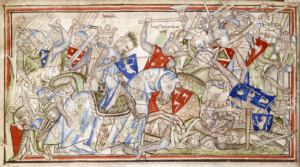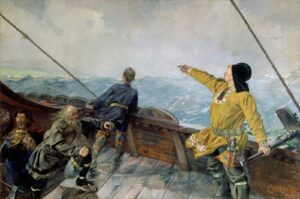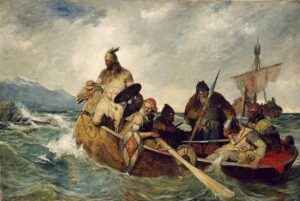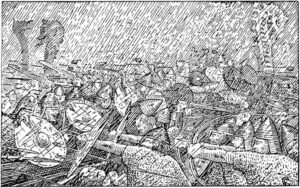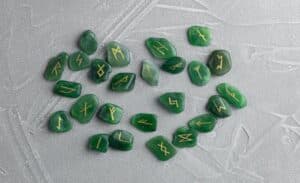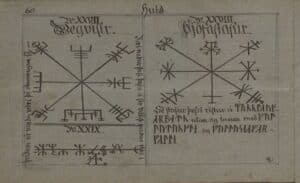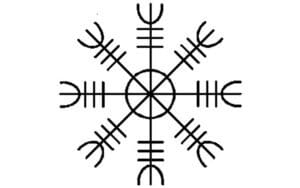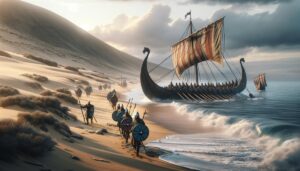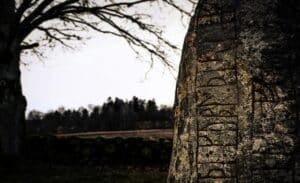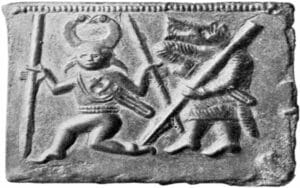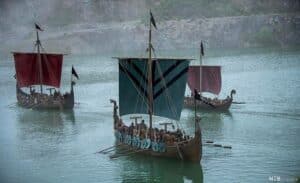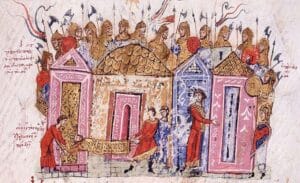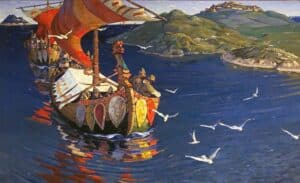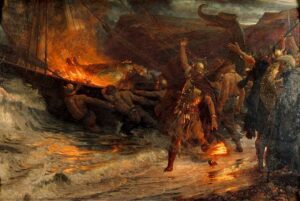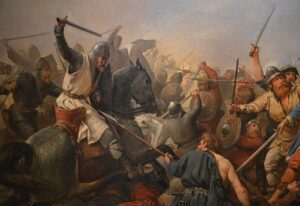-
Ivar the Boneless – Separating Myths and Facts
Ivar Ragnarsson, aka. Ivar the Boneless, was a viking chieftain who led the Great Heathen Army when it invaded Britain … Read More
-
Rollo of Normandy – The First Viking Ruler of Normandy
Rollo is a fascinating historical viking chieftain and best known for being the first ruler of Normandy. However, when he … Read More
-
Viking Names for Boys – Curated List
A couple of weeks ago, my daughter Oda and I collaborated on creating a list of viking age names for … Read More
-
319 Female Viking Names (With Top Twelve List)
Choosing a name for your child, or someone you love can undoubtedly be a difficult task. If you are looking … Read More
-
Harald Hardrada – The Last Viking King
Harald Sigurdsson (Old Norse Haraldr Sigurðarson) is popularly known as the last viking king. That’s not to say he wasn’t … Read More
-
Ragnar Lothbrok | Separating Legend from History
Ragnar Lothbrok Sigurdsson, (Old Norse Ragnarr Loðbrók) has risen from the old sagas to become one of the best known … Read More
-
Leif Erikson – History of the Man Who Discovered America
Leif Erikson is known as the viking explorer who “discovered” America, as the first European, centuries ahead of Columbus. Obviously … Read More
-
Erik the Red | Hot-Headed Vikingr Explorer
When you think of famous Vikings, one name that might come to mind is Erik the Red, Old Norse “Eirikr … Read More
-
Eric Bloodaxe | The Brother Slayer
This isn’t Shakespeare so when you ask what’s in a name you won’t get a flowery, metaphor-filled answer. We are … Read More
-
Westward Expansion In The Viking Age
What exactly caused the massive westward expansion of Vikings in the late 8th century? There is, as of now, no … Read More
-
The Laws of the Jómsvikings (Vikings from Jóm)
The Jómsvíkinga Saga is from the thirteenth century, and believed to have been written down the first time in Iceland. … Read More
-
The Elder Futhark Runes | Meaning & Symbolism | Quiz
The Elder Futhark and the Younger Futhark are two ancient runic writing systems used by the Old Norse people in … Read More
-
Viking Symbols – A Major Part of Old Norse Myths and Culture
Symbols played a significant role in the culture and Norse mythology . With no real boundaries between the gods, magic … Read More
-
Aegishjalmr: Mystery of the Helm of Awe
When diving into writing about the Helm of Awe, it’s important to point out a few things right from the … Read More
-
The Viking Raid in Africa
In the heart of the Viking Age, a time when the Norsemen’s sails dominated the seas, a story unfolded that would extend their saga beyond the familiar fjords of Scandinavia to the distant shores of Africa.
-
The “Valknut” Symbol – A Case of Mistaken Identity
Part of what people find most captivating about Old Norse mythology are the many Viking symbols it contains. Of course, … Read More
-
Berkanan: The Rune of Growth and Fertility in the Viking Age
Imagine, if you will, a time when the Norse gods roamed the earth, and the runes were their language. Among … Read More
-
Mannaz: Unraveling the Mysteries of Mankind’s Rune in the Viking Age
Imagine, if you will, a time when the Norse roamed the earth, their lives intertwined with a mystical system of … Read More
-
Ingwaz: The Seed of Life in the Elder Futhark Runes
In the ancient world, symbols held a profound significance. One such symbol, a rune from the Elder Futhark system, has … Read More
-
Dagaz: The Dawn of Understanding in the Elder Futhark
As I delve into the mysteries of the Elder Futhark, a runic system that whispers the wisdom of our ancestors, … Read More
-
Othala: The Ancestral Homestead in the Elder Futhark
As we journey through the Elder Futhark, we find ourselves at the end of the runic alphabet with the Othala … Read More
-
Tiwaz: The Rune of Justice in the Viking Age
Picture this: a Viking warrior, his hand gripping a runestone etched with a unique symbol. This symbol, a simple vertical … Read More
-
Isa – Unveiling the Icy Mysteries of the Elder Futhark
In this post I am delving into one of my favourite runes, Isa, or īsaz. It’s the eleventh rune in … Read More
-
Perthro: Unveiling the Mysteries of the Elder Futhark’s Cup Rune
As I am working through all the runes of the Elder Futhark, we come to a really unique one. It … Read More
-
Wunjo: Unveiling the Joyous Rune of the Elder Futhark
Welcome back, fellow seekers of ancient wisdom! Today, we’re journeying once more into the world of the Vikings and their … Read More
-
Gebo | The Gift or Exchange Rune From the Elder Futhark
Gebo is the seventh rune of the Elder Futhark. In this post I will be exploring the meaning of Gebo, … Read More
-
Unveiling the Mysteries of the Raidho Rune
The rune Raidho is the fifth rune, in the first aett in the Elder Futhark. In this post I will … Read More
-
Unraveling Ansuz – Exploring the Viking Rune’s Ancient Wisdom
In this post, I’ll be looking at the Ansuz rune, from the first aett of the Elder Futhark. The likely … Read More
-
Thurisaz – The Thorn of the Elder Futhark
The Elder Futhark rune Thurisaz is a giant among the runes, literally associated with the jötnar from Norse mythology. In … Read More
-
Uruz – The Power and Mystery of the Aurochs Rune
The Elder Futhark, an ancient Germanic alphabet etched into the annals of time, whispers tales of our forebears, the Vikings. … Read More
-
Fehu | Elder Futhark Rune Symbol of Cattle and Wealth
In the early days of the Germanic peoples, a mysterious script was born – the Elder Futhark. Among the twenty … Read More
-
Norse Runes from the Younger Futhark
The Norse runes of the Younger Futhark are a mysterious as they are ancient. The fascinating symbols have captured the … Read More
-
Laguz: Unraveling the Mysteries of Water in the Elder Futhark
As the last rays of the sun kiss the horizon goodbye, we gather around the warmth of the fire, ready … Read More
-
Ehwaz: The Steed of the Elder Futhark
Imagine, if you will, a time when the clatter of hooves echoed through the valleys of Scandinavia. A time when … Read More
-
Algiz: The Protective Rune of the Elder Futhark Unveiled
Diving once again into the captivating realm of Viking Age symbolism, we turn our attention to the Elder Futhark, the … Read More
-
Jera – The Harvest Rune of the Elder Futhark Unveiled
In this post we’re journeying once more into the world of the Vikings and their enigmatic runic system, the Elder … Read More
-
Eiwaz – Unveiling the Yew Rune of the Elder Futhark
In this post, we’ll be journeying once more into the world of the Vikings and their enigmatic runic system, the … Read More
-
Hagalaz – Unearthing the Hailstone Rune of the Elder Futhark
Welcome back, fellow seekers of ancient wisdom! Today, we’re journeying once more into the world of the enigmatic runic alphabet, … Read More
-
Nauthiz – Unraveling the Necessity Rune of the Elder Futhark
In this post, I will explore the Elder Futhark rune Nauthiz and its symbolism. Nauthiz is the second rune, in … Read More
-
Sowilo rune: The Sunlit Path of the Vikings
Let’s embark on a journey, a journey back in time. Picture this: the early Viking Age, a time of exploration, … Read More
-
Torch of Knowledge – The Kenaz Rune
Kenaz is the sixth rune of the Elder Futhark, found in the first of its three aetts. It has some … Read More
-
Myths and Reality of Berserkers and Ulfhednar
In this post, I’ll be exploring the fascinating world of Viking Age Berserkers and Ulfhednar. While they have some differences, … Read More
-
Seidr: The Ancient Magic of the Norse World
The Viking Age, a period marked by exploration, trade, and conquest, gave birth to Seidr. This indigenous Norse practice might … Read More
-
The Viking Ships
The Viking ships were used both before and during, as well as after the time known as the Viking Age … Read More
-
Old Norse Concept of Fate and The Web of Wyrd
The Vikings’ view on fate and how they believed their life and death were predestined has always fascinated me. In … Read More
-
The Varangian Guard | Old Norse Elite Viking Warriors
The Varangians were, initially, primarily Swedish Rus (Vikings from Sweden). They had sailed and rowed their ships down the long … Read More
-
Rus Vikings In Eastern Europe and Byzantium
Fierce Vikings, mainly from Sweden, spread throughout all of Eastern Europe. They came to be known as “The Rus.” The … Read More
-
The First And Second Viking Age in Ireland
Ireland before the Vikings Before the Viking invasion of Ireland began, 8th-century Irish culture and politics were homogeneously Gaelic. The … Read More
-
Britain In The Viking Age
Vikings in Britain – Their Lasting Legacy England had been in contact with Scandinavians long before the first recorded Viking … Read More
-
The Vikings And Their Eastern Expansion
People know about the Vikings in England, but what about the Viking’s eastern expansion? The Danelaw in England was just … Read More

